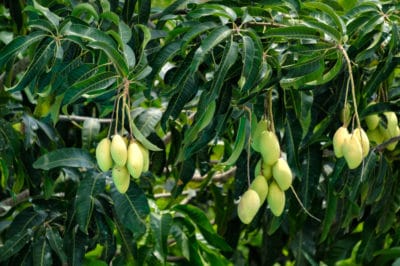Seed Grown vs. Grafted Mango Trees
The method of propagation defines how many years you will have to wait before you can expect the mango tree to bear fruit. Once they reach the appropriate age, depending on the method of propagation, all mango trees seem to continue to bear yearly crops for about 10 years, then seem to bear heavier crops one year and a lighter crop the next.
Trees Propagated Through Seeds
Mangos are easily propagated through their seeds, though the type of seed defines what type of fruit you can expect. Seed-grown trees take about six years before they begin flowering and bearing their first crop of mangos. The different types of seeds and their characteristics include:
- Polyembyonic Seeds: Trees produce the same quality of fruit as the parent tree. Indochinese mangos produce these type of seeds and you can identify these trees by their fruit. The fruit is elongated and usually green or yellow.
- Monoembyonic Seeds: Trees produce fruit of the same, lower, or a better quality than the parent tree. Indian mangos produce these type of seeds and you can identify these types of trees by their fruit. The mangos are colorful and roundish.
Grafted Mango Trees
Mango trees propagated through grafting have had a section of the parent tree, which has desirable qualities, grafted onto a desirable rootstock, usually one that is hardy and withstands disease. If you look closely at the lower portion of the tree’s trunk, you can see the union where the two sections were grafted together.
You are most likely to find grafted trees at your local nursery, because the quality of the fruit is certain. If you are looking for a mango tree that produces fruit sooner, you’ll want to plant a grafted tree. Grafted mango trees start bearing their first flowers and fruits around three to five years of age.
An Abundant Bounty
Once your mango trees starts flowering and developing fruit, you can expect to harvest your bounty in about four or five months. These are long-lived trees and if grown in proper conditions and given appropriate care, you can expect your tree to live for a hundred years or more.
Once the mango tree reaches 10 to 20 years-old, you can expect to harvest approximately 300 mangos yearly. Double that age and you can double the amount of annual fruits you can expect. It’s not unusual for mango trees to produce 1500 mangos per year. One of the oldest known mango trees, over 100 years-old, produced 29,000 mangos one year.
With a little patience and continued care, before you know it, you’ll be harvesting more of these delectable tropical fruits than you’ll probably know what to do with. Mangos are tasty eaten fresh, used in drinks, salads or used in preserves.
Expert Tip: Always wash the sap off fresh mangos. If not, the sap causes black spotting, which leads to rot. In addition, some people are allergic to the sap, so consider wearing gloves when handling them.
